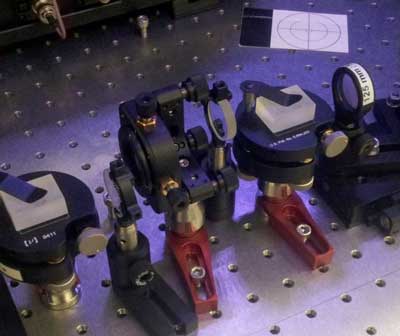| Posted: May 18, 2018 |
Can a quantum drum vibrate and stand still at the same time?
(Nanowerk News) Researchers have studied how a 'drumstick' made of light could make a microscopic 'drum' vibrate and stand still at the same time.
|
|
A team of researchers from the UK and Australia have made a key step towards understanding the boundary between the quantum world and our everyday classical world.
|
|
Quantum mechanics is truly weird. Objects can behave like both particles and waves, and can be both here and there at the same time, defying our common sense. Such counterintuitive behaviour is typically confined to the microscopic realm and the question "why don't we see such behaviour in everyday objects?" challenges many scientists today.
|
|
Now, a team of researchers have developed a new technique to generate this type of quantum behaviour in the motion of a tiny drum just visible to the naked eye. The details of their research are published today in New Journal of Physics ("Generation of mechanical interference fringes by multi-photon counting").
|
 |
| The first quantum drum test. (Image: Imperial College London)
|
|
Project principal investigator, Dr Michael Vanner from the Quantum Measurement Lab at Imperial College London, said: "Such systems offer significant potential for the development of powerful new quantum-enhanced technologies, such as ultra-precise sensors, and new types of transducers.
|
|
"Excitingly, this research direction will also enable us to test the fundamental limits of quantum mechanics by observing how quantum superpositions behave at a large scale."
|
|
Mechanical vibrations, such as those that create the sound from a drum, are an important part of our everyday experience. Hitting a drum with a drumstick causes it to rapidly move up and down, producing the sound we hear.
|
|
In the quantum world, a drum can vibrate and stand still at the same time. However, generating such quantum motion is very challenging. lead author of the project Dr Martin Ringbauer from the University of Queensland node of the Australian Research Council Centre for Engineered Quantum Systems, said: "You need a special kind of drumstick to make such a quantum vibration with our tiny drum."
|
|
In recent years, the emerging field of quantum optomechanics has made great progress towards the goal of a quantum drum using laser light as a type of drumstick. However, many challenges remain, so the authors' present study takes an unconventional approach.
|
|
Dr Ringbauer continues: "We adapted a trick from optical quantum computing to help us play the quantum drum. We used a measurement with single particles of light--photons--to tailor the properties of the drumstick.
|
|
"This provides a promising route to making a mechanical version of Schrodinger's cat, where the drum vibrates and stands still at the same time."
|
|
These experiments have made the first observation of mechanical interferences fringes, which is a crucial step forward for the field.
|
|
In the experiment, the fringes were at a classical level due to thermal noise, but motivated by this success, the team are now working hard to improve their technique and operate the experiments at temperatures close to absolute zero where quantum mechanics is expected to dominate.
|
|
These future experiments may reveal new intricacies of quantum mechanics and may even help light the path to a theory that links the quantum world and the physics of gravity.
|

